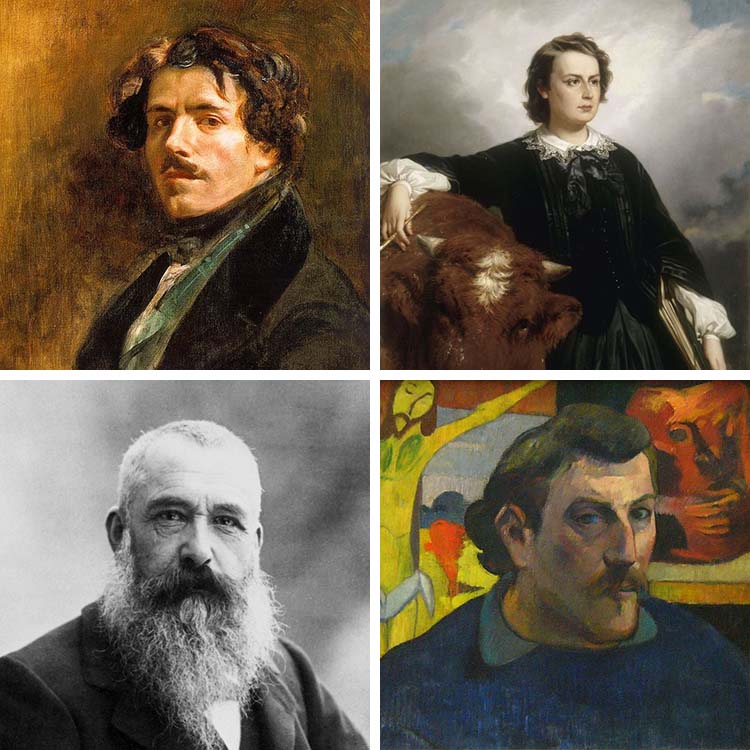
There’re countless artists from across the globe who have shaped the art world as we know it today. However, France has been home to many of the most famous and influential painters in Western history. Art was—and still is—an essential part of French culture, and was nurtured even from its ancient beginnings.
Over the centuries, the country’s rulers—such as Louis XIII and Louis XIV—welcomed and championed artistic endeavors, and even contributed to the founding of the French Academy of Fine Art. This rich artistic environment provided fertile grounds for many of the revolutionary art movements we know today, such as French Baroque, and the Rococo style of the 17th and 18th centuries. However, this environment also gave rise to a group of artists, later called the Impressionists, that would shake France’s established artistic traditions to the core and mark the beginnings of Modernism.
From Neoclassical painters like Jacques-Louis David to Impressionist painters such as Claude Monet and Camille Pissarro, here’s our list of famous French artists you should know.
French Neoclassical Painters
Neoclassicism is an 18th-century art movement based on the ideals of art from Rome and Ancient Greece. Its interest in simplicity and harmony was partially inspired by a negative reaction to the overly frivolous aesthetic of the decorative Rococo style.
Jacques-Louis David (1748–1825)
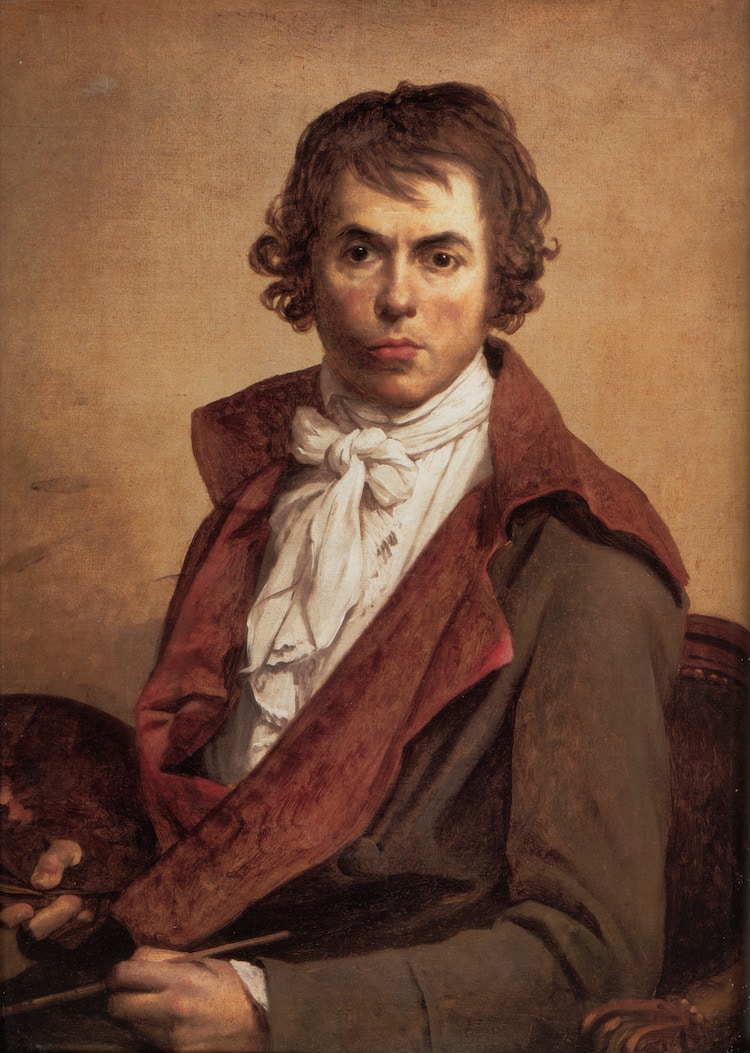
Jacques-Louis David, “Self-Portrait,” 1794 (Photo: Louvre via Wikimedia Commons, Public domain)
Most consider Jacques-Louis David (1748–1825) to be the leading Neoclassical painter of the era. Originally from Paris, he received a robust and well-rounded education in fine art that honed his talents and helped him become a sensation at the Salon. He produced art that was unlike the Rococo status quo—with few colors, minimalist but balanced compositions, and depictions of classical subject matter. During the French Revolution, he affiliated himself with Maximilien Robespierre and created art that supported his side. Later, when Napoleon rose to power, David realigned himself again and made art in support of the new regime. His art had a far-reaching impact on Neoclassical artists across Europe.
Famous works of art: The Oath of the Horatii (1784–1785), The Death of Socrates (1787), Death of Marat (1793), Napoleon Crossing the Alps (1801–1805)
Jean-Auguste-Dominique Ingres (1780–1867)
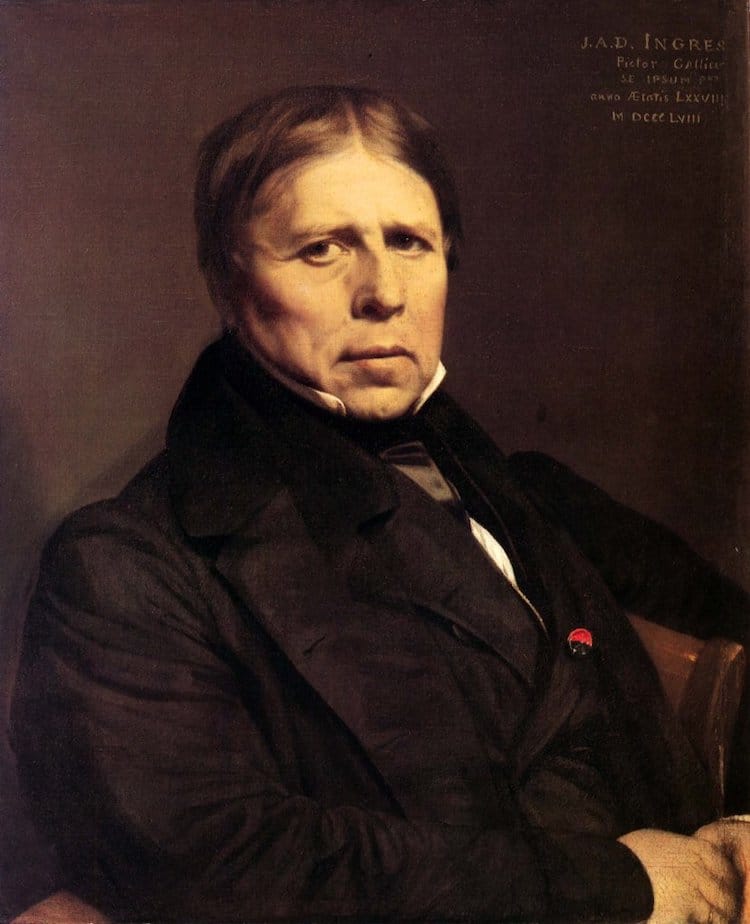
Ingres, “Self-Portrait at 78,” 1858 (Photo: The Uffizi via Wikimedia Commons, Public domain)
Born a couple of decades after David, French artist Jean-Auguste-Dominique Ingres (1780–1867) inherited the Neoclassical tradition and created art that was largely academic in style. His skills as one of the best draftsmen helped him create compelling portraiture, most of which are his best-known works. Later, when Romanticism arose as another leading art movement, Ingres and Eugène Delacroix were pitted against each other as symbols of the old and new styles.
Significant works: The Grande Odalisque (1814)
French Romantic Painters
Romanticism was a cultural movement that emerged around 1780. Until its onset, Neoclassicism dominated 18th-century European art, typified by a focus on classical subject matter, an interest in aesthetic austerity, and ideas in line with the Enlightenment, an intellectual, philosophical, and literary movement that placed emphasis on the individual.
Théodore Géricault (1791–1824)
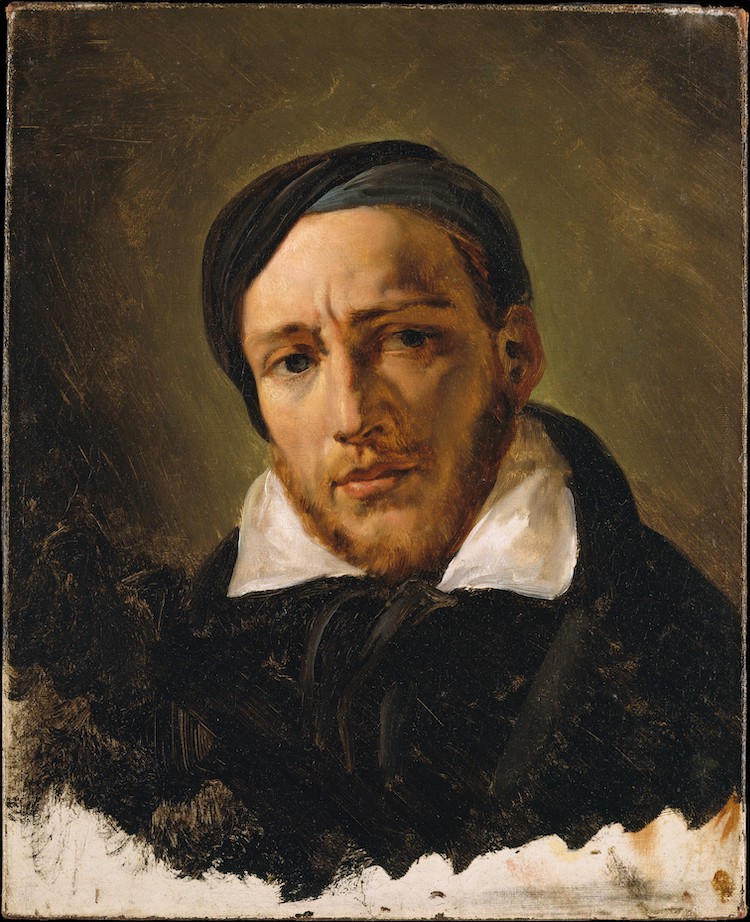
Horace Vernet, “Portrait of Jean-Louis-André-Théodore Gericault,” 1822–1823(Photo: The Met via Wikimedia Commons, CC0 1.0)
Although he only lived to be 32 years old, Jean-Louis André Théodore Géricault (1791–1824) had a lasting impact on the course of the Romantic movement. His dramatic painting The Raft of the Medusa, which depicted the emotional and physical aftermath of a contemporary French shipwreck, captured the imaginations of both the Paris Salon and the young Eugène Delacroix, who credited this work as the impetus behind his Romantic style.
Famous works of art: The Raft of Medusa (1818–1819)
Eugène Delacroix (1798–1863)
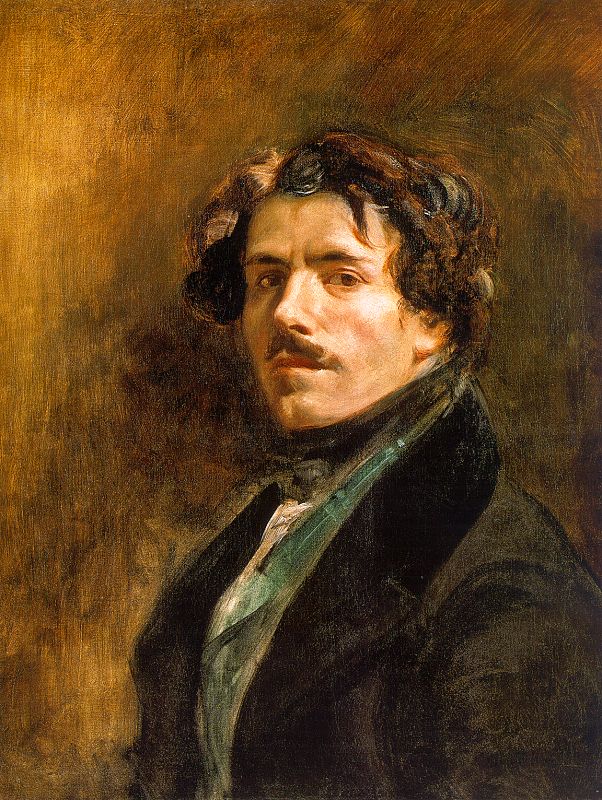
Eugène Delacroix, “Self-Portrait,” 1837 (Photo: Louvre Museum via Wikimedia Commons, Public domain)
A master of color, movement, and drama, Eugène Delacroix was a leader of the Romanticism art movement and an influential figure in the work of the Impressionists. Finding inspiration in the masters of the Venetian School and in the art of Baroque painter Peter Paul Rubens, Delacroix discovered that through color, visible brushstrokes, and dynamic compositions, he could convey drama, movement, and especially, emotion—which was the foundation of all Romantic art. Delacroix’s oeuvre spanned contemporary events, mythological scenes, Orientalism, and portraiture.
Famous works of art: The Death of Sardanapalus (1827), Liberty Leading the People (1830)
French Realist Painters
Realism emerged in France in the 1850s. On the heels of the 1848 Revolution—an event that established the “right to work” in the country—the movement introduced the idea of average, working-class people, contemporary settings, and day-to-day scenes as worthy artistic subjects.
Jean-François Millet (1814–1875)
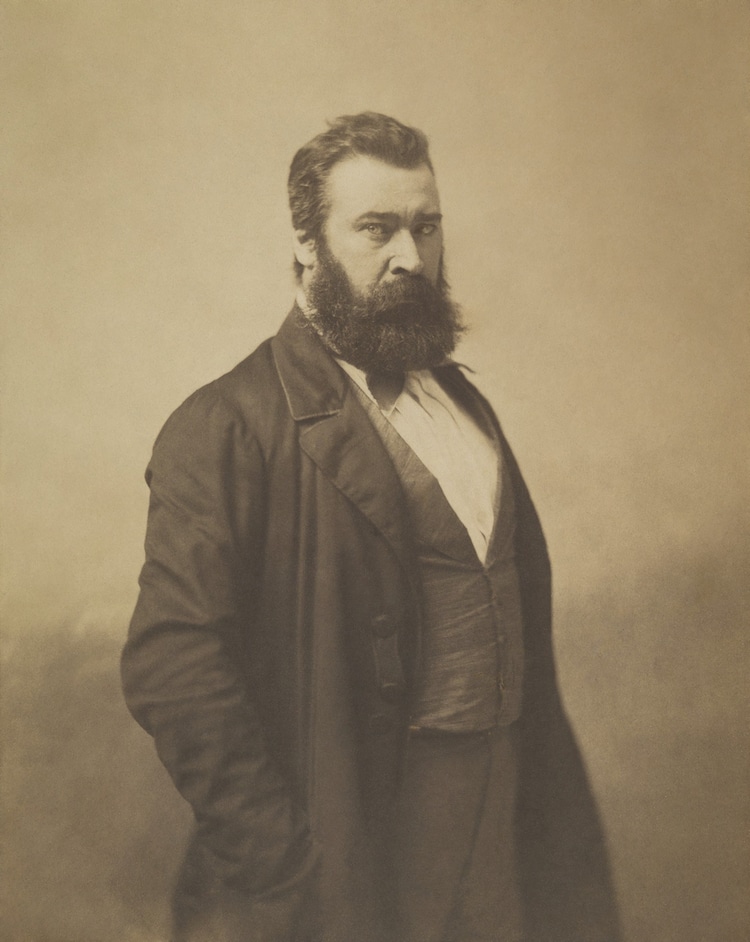
Photograph of Jean-François Millet by Nadar, 1856–1858 (Photo: Wikimedia Commons, Public domain)
Based in rural France, Jean-François Millet focused on portrayals of working-class people, particularly farmers. “Peasant subjects suit my nature best,” he said, “for I must confess…that the human side is what touches me most in art.” In addition to being a premier Realist painter, Millet is also known for his role in founding the Barbizon school—a group of artists who came together to challenge the dominance of Romanticism. He was often cited as a great source of inspiration for Dutch Post-Impressionist Vincent van Gogh.
Famous works of art: The Gleaners (1857)
Gustave Courbet (1819–1877)
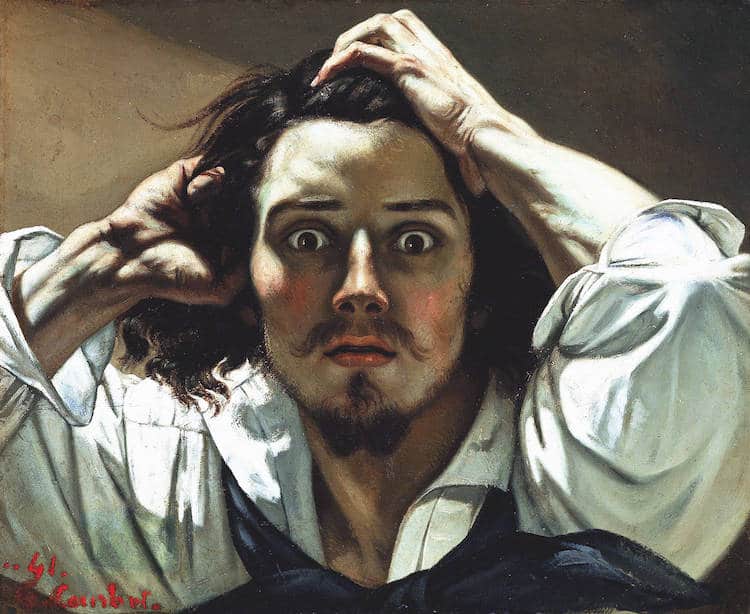
Gustave Courbet, “Self-Portrait as the Desperate Man,” 1845 (Photo: Wikimedia Commons, Public domain)
Gustave Courbet is often considered the leading figure of Realism. He laid the groundwork for the movement in the 1840s, when he began portraying peasants and laborers on a grand scale typically reserved for religious, historical, or allegorical subjects. “It is society at its best, its worst, its average,” he said of his practice. “In short, it’s my way of seeing society with all its interests and passions. It’s the whole world coming to me to be painted.”
Famous works of art: The Stone Breakers (1849), The Burial at Ornans (1849–1850)
Rosa Bonheur (1822–1899)
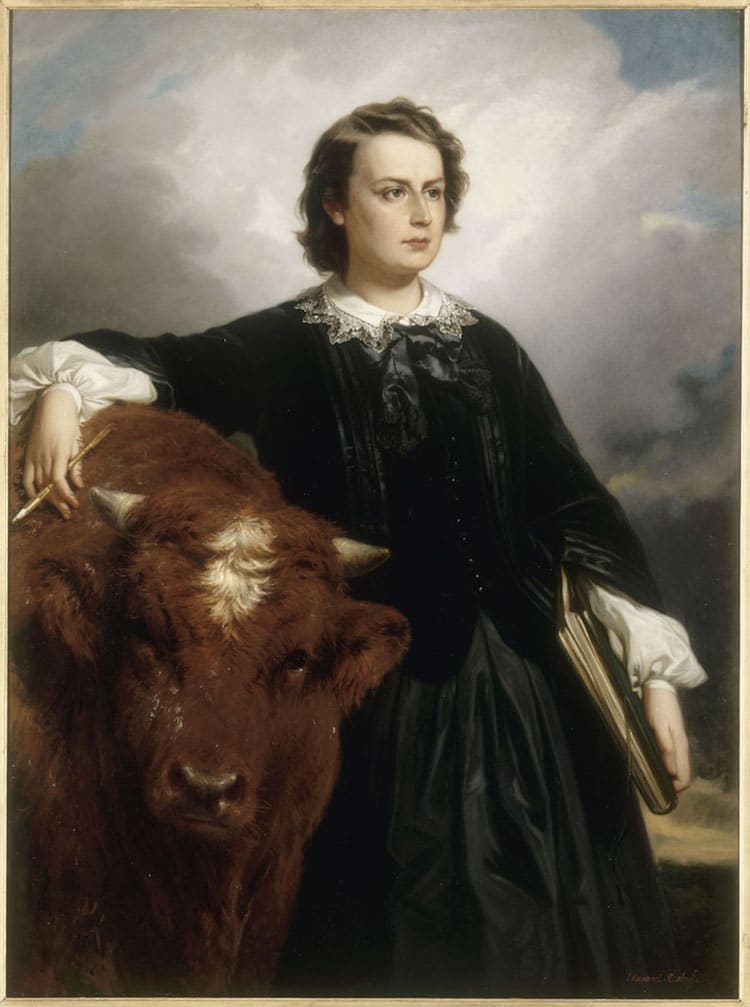
Edouard Louis Dubufe, “Rosa Bonheur with Bull,” 1857 (Photo: Wikimedia Commons, Public domain)
The 19th-century Realist painter Rosa Bonheur was known for her stunning paintings of animals ranging from horses to bulls to rabbits. Living in a French country chateau she purchased, Bonheur never married. She wore her hair short, obtained a then-necessary permit to wear men’s clothes, and even owned a pet lioness. She was the first female artist awarded the Légion d’Honneur after Empress Eugénie visited her studio. The empress famously declared that “Genius has no sex” after viewing Bonheur’s paintings.
Famous works of art: The Horse Fair (1852–1853)
French Impressionist Painters
Developed in France during the 19th century, the Impressionist movement was based on the spontaneous practice of painting outside (en plein air). It was pioneered by a unique group of artists who decided to abandon traditional painting approaches in favor of frantic brushstrokes and unique color palettes—something that was incredibly progressive for the time. In contrast to the realism enforced by the art establishment, their paintings captured emotional “impressions” of fleeting moments found in everyday life.
Camille Pissarro (1830–1903)
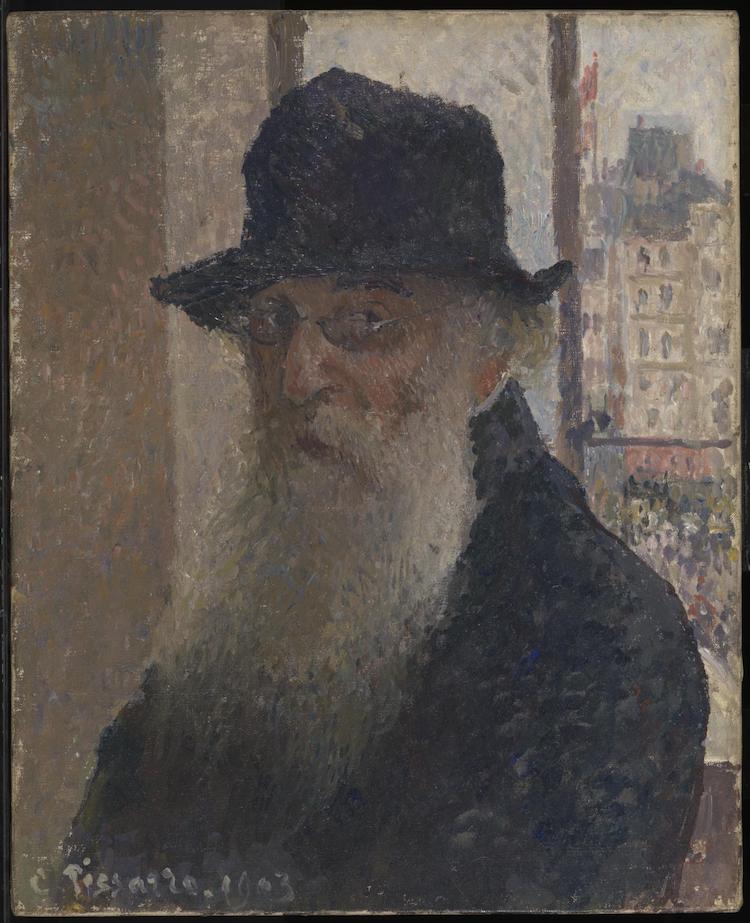
Camille Pissarro, “Self-Portrait,” 1903 (Photo: Tate , CC-BY-NC-ND 3.0, Unported)
Interestingly, Camille Pissarro (1830–1903) contributed to both Impressionism and the reactionary movement against it, Post-Impressionism. Much like other artists of the time, Pissarro’s work was mocked and rejected by critics. He and his friends, such as fellow greats Claude Monet and Paul Cézanne created a group that were exhibited at the Salon des Refusés (Exhibition of Rejects), as an alternative to the mainstream Salon de Paris.
During the latter part of his career, Pissarro created a series of oil paintings depicting French cityscapes at different times of the day and during various weather conditions.
Famous works of art: Boulevard Montmartre series (1897)
Édouard Manet (1832–1883)
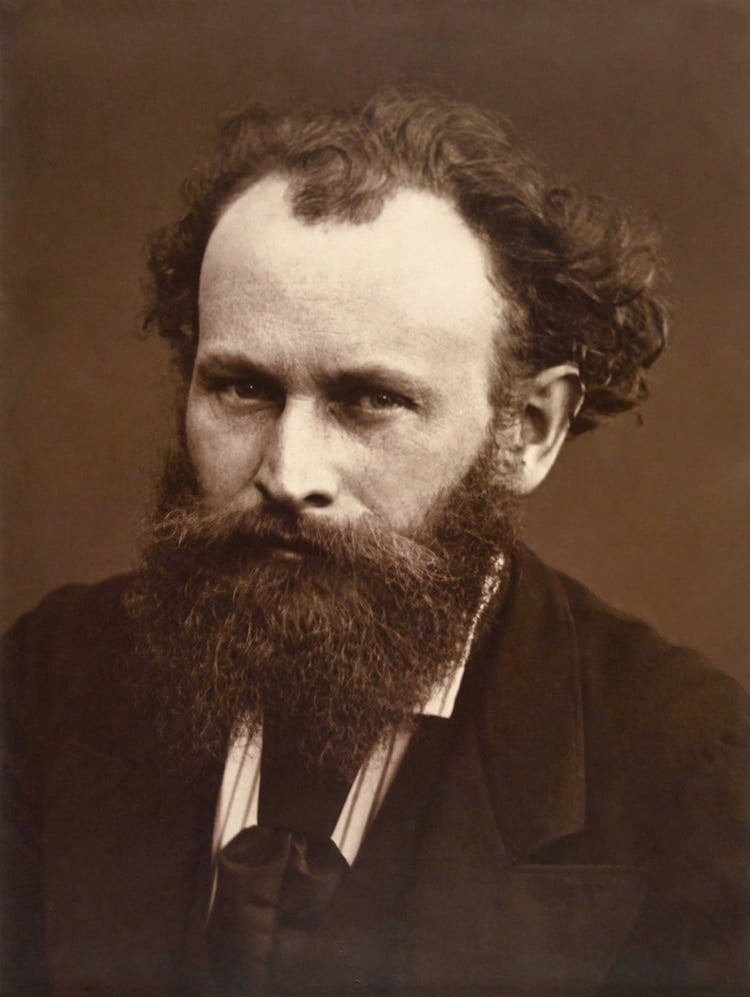
Close-up photograph of artist Édouard Manet, enlargement by Paul Nadar of his father’s original, before 1870 (Photo via Wikimedia Commons, Public domain)
Édouard Manet (1832-1883) was one of the first 19th-century artists to paint modern life and a pioneering figure who led the transition from Realism to Impressionism. Controversial at the time, his paintings depicted nude women—one of which was the French female painter, Victorine Meurent— who posed for several of Manet’s most famous paintings, including Olympia.
The most shocking thing for audiences at the time was not Olympia’s nudity, but several details that lead people to believe Meurent was depicted as a prostitute. These included the orchid in her hair, and symbols of wealth such as her pearl earrings and gold bracelet. Not to mention the name “Olympia” was associated with prostitutes in 1860s Paris.
Famous works of art: Olympia (1863), The Luncheon on the Grass (1863), A Bar at the Folies-Bergère (1882)
Edgar Degas (1834–1917)

Edgar Degas, “Self-Portrait,” 1854–1855 (Photo: Musée d’Orsay via Wikimedia Commons, Public domain)
Although he described himself as a Realist, Edgar Degas (1834–1917) is considered a member of the Impressionist movement. Famous for his paintings, sculptures, prints, and drawings, he was especially talented at capturing the beauty of dance. His paintings of ballerinas in motion express his momentary observations and visual experiences during dance classes and rehearsals.
Famous works of art: The Dance Class (1875), L’Absinthe (1875–1876)
Claude Monet (1840–1926)
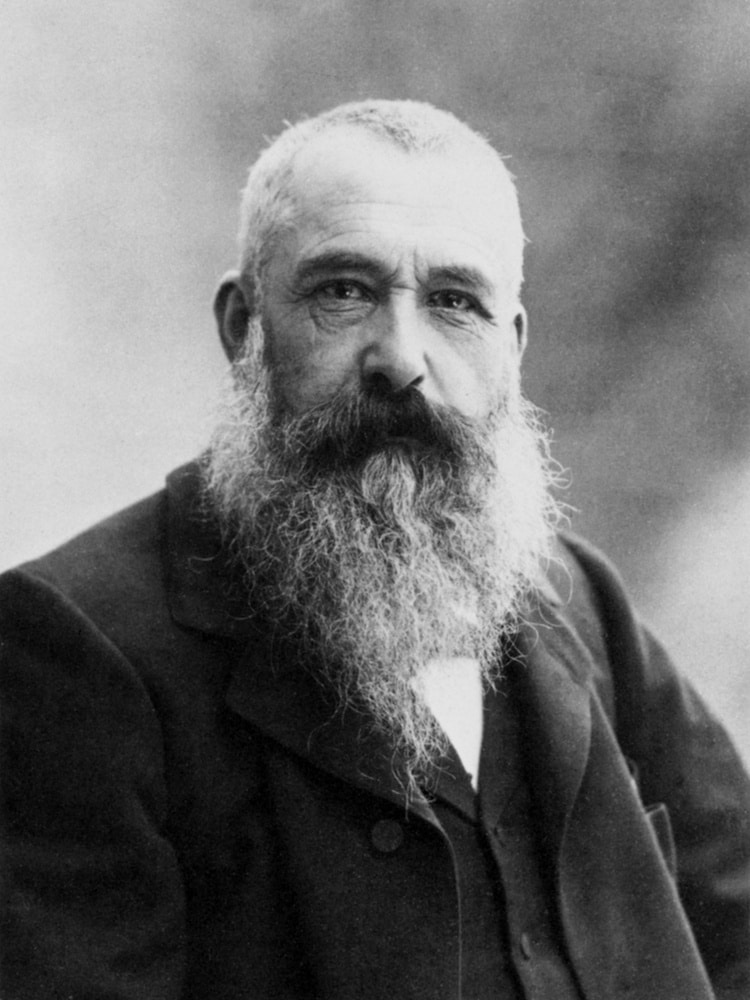
Portrait of Claude Monet by Nadar, 1899 (Photo: Wikimedia Commons, Public domain)
You could say that Claude Monet (1840–1926) was the father of Impressionism since both the artistic style and the movement’s title were derived from one of his own paintings, Impression, Sunrise, exhibited in 1874. Monet is famous for capturing the French countryside, especially water lily ponds. With a distinct paint stroke style and color palette, he was able to perfectly capture how the sunlight affected his subjects.
Famous works of art: Impression, sunrise (1872), Water Lilies series (1883–1926)
Pierre-Auguste Renoir (1841–1919)
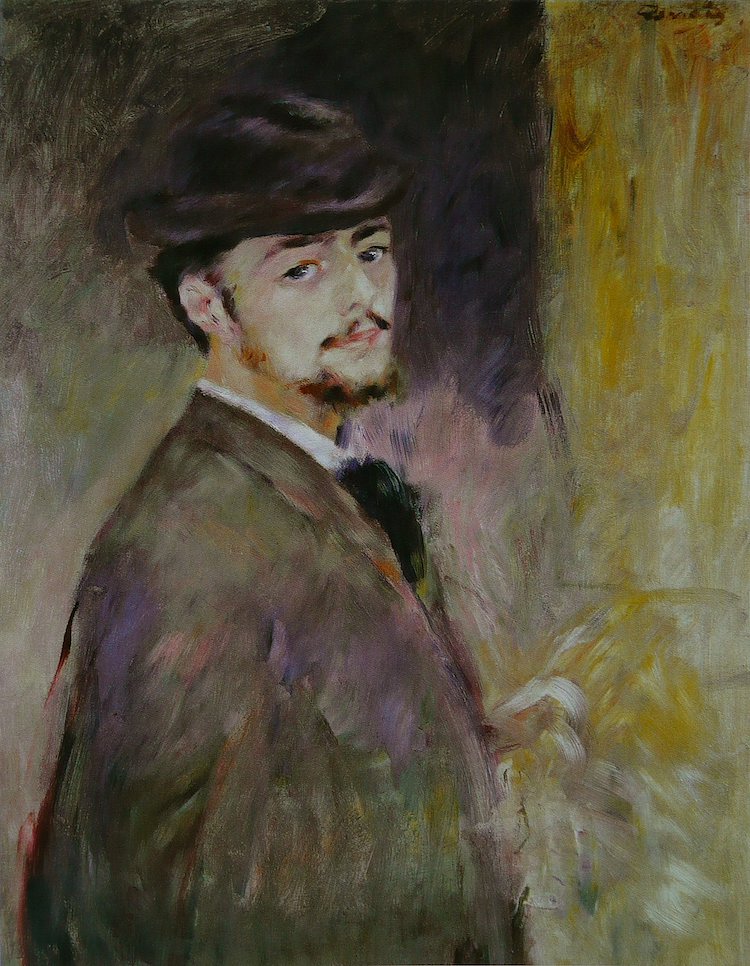
Pierre-Auguste Renoir, “Self-Portrait,” 1876 (Photo: Fogg Art Museum via Wikimedia Commons, Public domain)
In characteristic Impressionist style, Pierre-Auguste Renoir’s (1841–1919) freely-brushed paintings depict vibrant social scenes. One of his most celebrated masterpieces, Bal du moulin de la Galette, illustrates a Sunday afternoon at the Moulin de la Galette in the district of Montmartre, Paris. 19-century, working-class Parisians are pictured dancing, drinking, and eating French galettes (savory crêpes).
Famous works of art: Bal du moulin de la Galette (1876), Luncheon of the Boating Party (1880–1881)
Berthe Morisot (1841–1895)
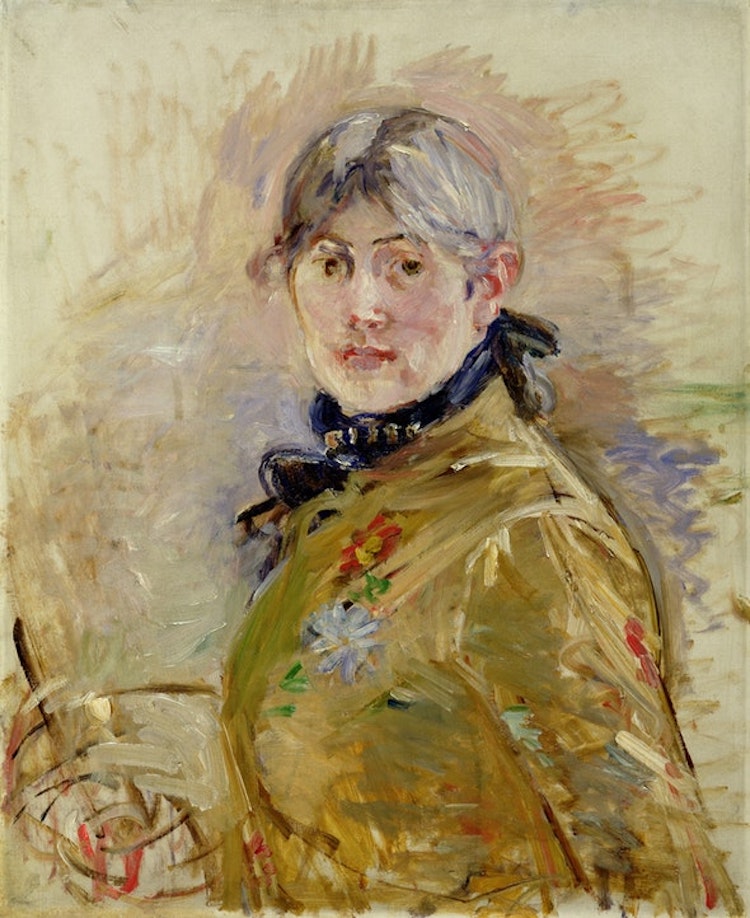
Berthe Morisot, “Self-Portrait,” 1885 (Photo: Wikimedia Commons, Public domain)
Berthe Morisot was an important Impressionist painter who was fully ensconced in the painterly world of late-19th century Paris. Although she first exhibited in the esteemed Paris Salon in 1864, she joined the “rejects” (her fellow Impressionists) in the monumental exhibit of 1874 which came to define the movement. Throughout her career, Morisot’s style was described as “feminine” for her use of soft color palettes and light brushstrokes.
Famous works of art: The Cradle (1872)
French Post-Impressionist Artists
Encompassing a wide range of artistic styles, the Post-Impressionist movement grew from a new wave of artists and their response to the Impressionist movement. Developed during the 1890s, rather than painting visual impressions of everyday life, Post-Impressionist painters often strived to express their own inner psychic feelings, often through the use of symbolism and vivid color. The work of these artists later led to Cubism and Abstract Expressionism.
Paul Cézanne (1839–1906)
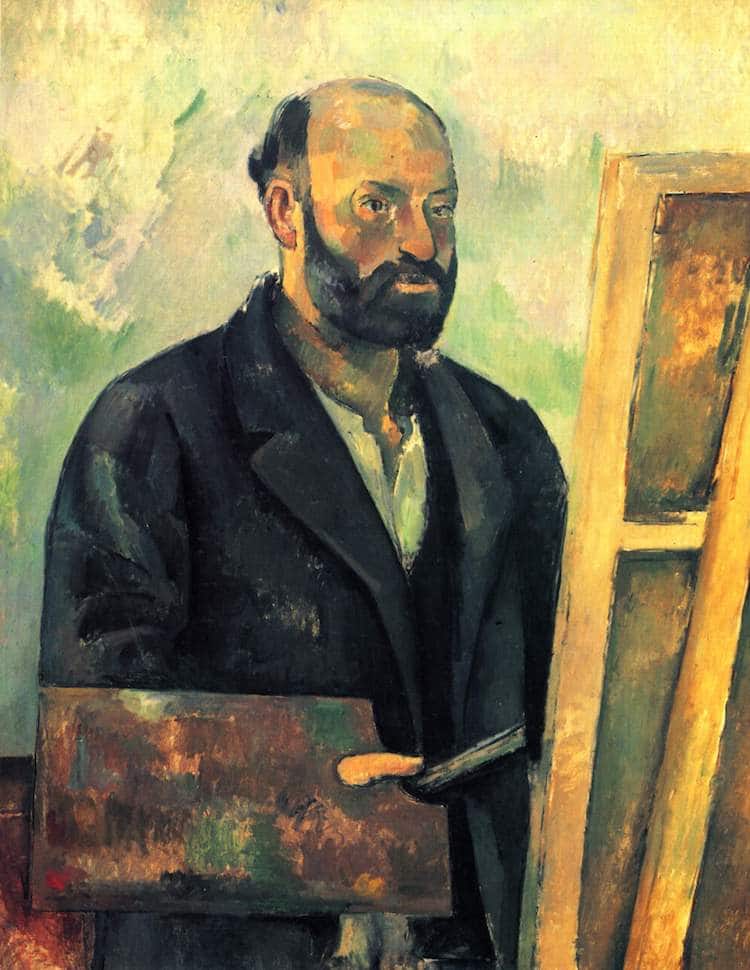
“Self-Portrait with Palette,” c. 1890 (Photo: The Yorck Project via Wikimedia Commons Public Domain)
Paul Cézanne’s (1839–1906) Post-Impressionist paintings depicted his intense studies of his subjects. Most famous for his still-life paintings, his distinctive brushstrokes and use of color laid the foundations for a radically different art world in the 20th century. Like most artists of the time, his work was ridiculed by critics and rejected by galleries. Yet, he was admired by younger artists who visited his studio in Aix, who considered him a master.
Famous works of art: Mont Sainte-Victoire (1885–1906), The Bathers (1898–1905)
Henri Rousseau (1844–1910)
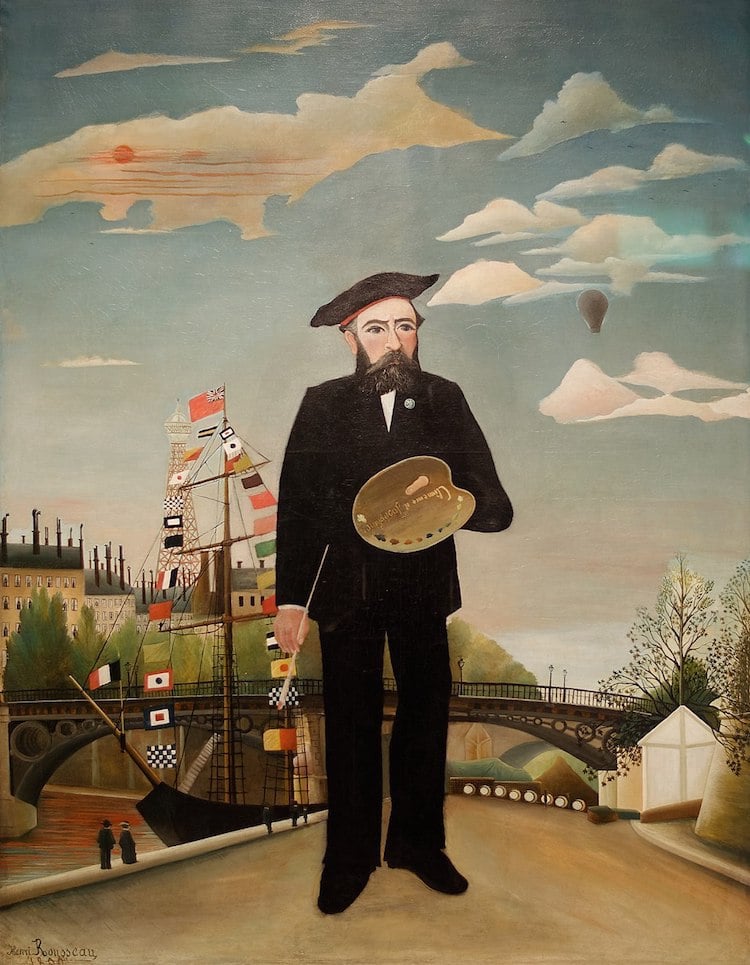
Henri Rousseau, “Myself,” 1890 (Photo: Wikimedia Commons, CC BY-SA 4.0)
Even though he never once left his home country, French Post-Impressionist painter Henri Rousseau (1844–1910) is most well-known for his nature-inspired exotic jungle scenes. He was inspired by illustrations in children’s books and the botanical gardens of Paris. Self-taught with no formal training, Rousseau is considered to be a naïve painter, and his work was often ridiculed by critics who claimed he painted like a child. Today, his work is highly celebrated and has influenced many modern artists.
Famous works of art: Tiger in a Tropical Storm (1891), The Sleeping Gypsy (1910), The Dream (1910)
Paul Gauguin (1848–1903)
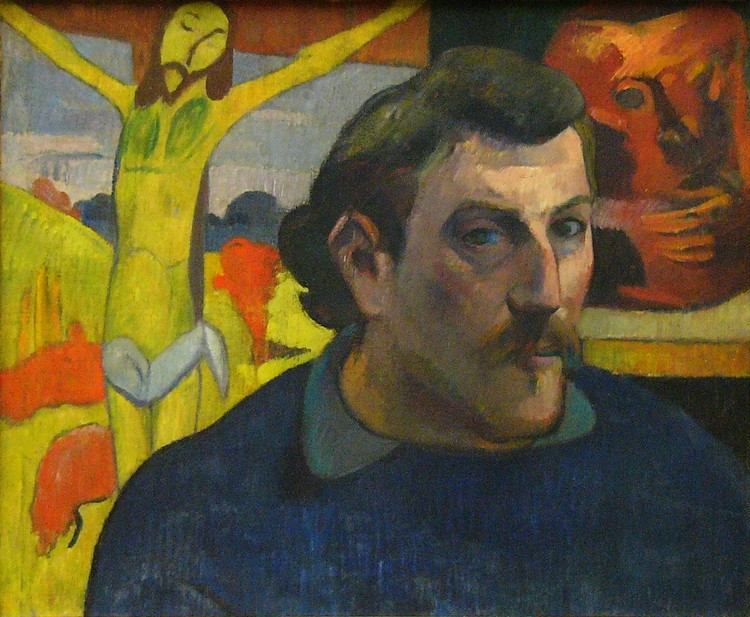
Paul Gauguin, “Self-Portrait with the Yellow Christ,” 1891 (Photo: Musée d’Orsay via Wikimedia Commons, Public domain)
One of the most significant French painters of the Post-Impressionist movement, Paul Gauguin (1848–1903) experimented with new color theories and new stylistic approaches to painting. He famously worked alongside Vincent Van Gogh during a summer in the south of France, before abandoning his life in Western society altogether. In the early 1890s, he began traveling regularly to the south Pacific where he developed a new style that married his day-to-day observations with mythical symbolism. This style was strongly influenced by the so-called “primitive” arts of Africa, Asia, and French Polynesia.
Famous works of art: The Yellow Christ (1889), Where Do We Come From? What Are We? Where Are We Going? (1897)
Georges Seurat (1859–1891)
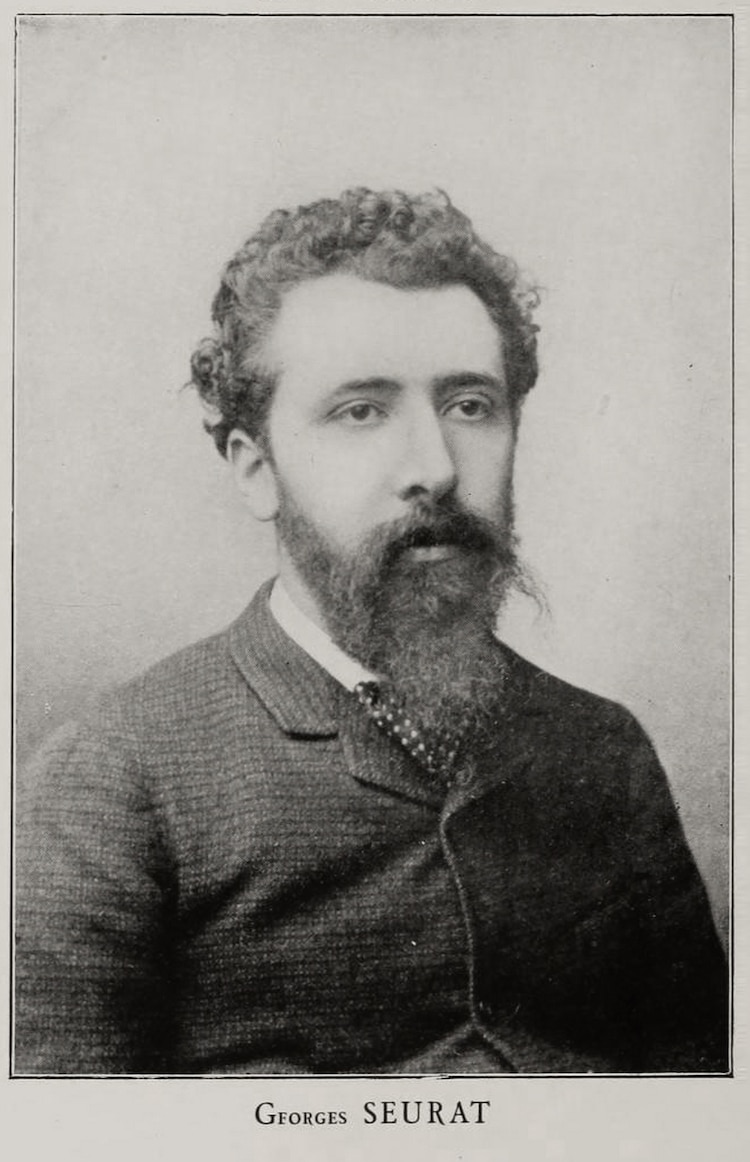
Portrait photograph of Georges Seurat, 1888 (Photo: Wikimedia Commons, Public domain)
Color theorist and painter Georges Seurat (1859–1891) is best known for developing the Pointillist style which he co-created with fellow artist Paul Signac. This scientific approach involved painting with distinct dots of color, which are meticulously applied in patterns to compose a cohesive image. Seurat’s large-scale masterpiece A Sunday Afternoon on the Island of La Grande Jatte remains a leading example of this style.
Famous works of art: A Sunday Afternoon on the Island of La Grande Jatte (1884–1886)
Henri de Toulouse-Lautrec (1864–1901)
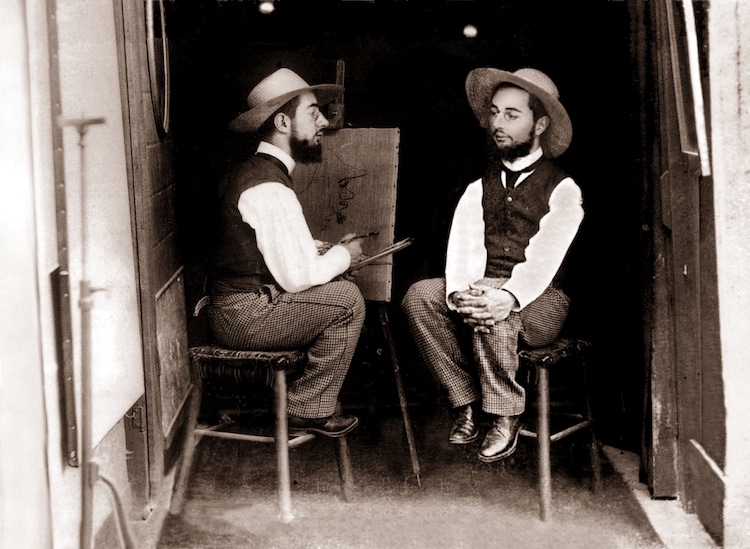
Gelatin silver print by Maurice Guibert of Henri de Toulouse-Lautrec as both artist and model (Photo: Wikimedia Commons, Public domain)
French painter, printmaker, draughtsman, caricaturist, and illustrator, Henri de Toulouse-Lautrec (1864–1901) is among the best-known painters of the Post-Impressionist period. A master at capturing crowds, his most famous works include depictions of the colorful, lively, and sometimes decadent lives of Parisians during the 19th century. During his 20-year career, he produced almost 1000 paintings, countless drawings, and even ceramics and stained glassworks.
His oil-on-canvas painting At the Moulin Rouge, 1892–1895 depicts his dancer and photographer friends at the Moulin Rouge cabaret in Paris. In the background, on the right, you can see Toulouse-Lautrec himself.
Famous works of art: At the Moulin Rouge (1892–1895)
Find more inspiring creatives in our list of most famous artists from around the world.
This article has been edited and updated.
Related Articles:
How Impressionism Changed the Art World and Continues to Inspire Us Today
6 Important Impressionist Painters Who Shaped the Iconic Movement
Exploring the Vision and Diverse Styles of Post-Impressionism Pioneers
What is Modern Art? Exploring the Movements That Define the Groundbreaking Genre
Cubism: How Picasso and Others Broke From Tradition to Transform Modern Art
